Forest Cover in the Congo Basin: Consistency Evaluation of Seven Datasets
Abstract
1. Introduction
2. Materials and Methods
2.1. Studied Areas
2.1.1. Congo Basin Studied Area
- (i)
- Miombo, which contains the TEOW regions with “miombo woodlands”.
- (ii)
- Moist forest, which contain the TEOW regions with “costal”, “lowland”, or “swamp” forests.
- (iii)
- Savanna, which contain the TEOW regions with “forest–savanna mosaic” (Table A2).
2.1.2. Miombo Forest
2.1.3. Moist Forest
2.1.4. Savanna Forest
2.2. Land-Cover Data
2.3. Homogenization of Datasets and Forest Definition
2.4. Spatiotemporal Analyses
3. Results
3.1. Impact of Data Homogenization and Resampling on Forest/Non-Forest Masks
3.1.1. Congo Basin
3.1.2. Miombo Forest
3.1.3. Moist Forest
3.1.4. Savanna Forest
3.2. Forest/Non-Forest Agreement and Disagreement Between Products
3.2.1. The Congo Basin
3.2.2. Miombo Forest
3.2.3. Moist Forest
3.2.4. Savanna Forest
3.3. Identification of Land Classes Implicated in the Disagreements
3.3.1. Congo Basin
3.3.2. Miombo Forest
3.3.3. Moist Forest
3.3.4. Savanna Forest
3.4. Temporal Evolution of the Forest for Each Dataset
3.4.1. The Congo Basin
3.4.2. Miombo Forest
3.4.3. Moist Forest
3.4.4. Savanna Forest
4. Discussion
5. Conclusions
Author Contributions
Funding
Data Availability Statement
Acknowledgments
Conflicts of Interest
Appendix A
| Web Address Dataset Download | Date of Download | Reference Publication | |
|---|---|---|---|
| HILDA+ | https://doi.pangaea.de/10.1594/PANGAEA.921846?format=html#download | 6 December 2023 | Winkler et al., 2021 [17] |
| MODIST1 | https://appeears.earthdatacloud.nasa.gov/ | 21 March 2024 | Sulla-Menashe et al., 2019 [16] |
| MODISP2 | https://appeears.earthdatacloud.nasa.gov/ | 21 March 2024 | Sulla-Menashe et al., 2019 [16] |
| ESACCI | https://cds.climate.copernicus.eu/datasets/satellite-land-cover?tab=overview | 4 December 2023 | ESA. “Land Cover CCI Product User Guide Version 2”. 2017 [15] |
| GLCLU | https://storage.googleapis.com/earthenginepartners-hansen/GLCLU2000-2020/v2/download.html | 1 December 2023 | Potapov et al., 2022 [14] |
| GFW | https://storage.googleapis.com/earthenginepartners-hansen/GFC-2022-v1.10/download.html | 6 December 2023 | Hansen et al., 2013 [18] |
| TMF | https://forobs.jrc.ec.europa.eu/TMF/data | 1 March 2024 | Vancutsem et al., 2021 [19] |
| Miombo | Moist Forest | Savanna |
|---|---|---|
| Angolan miombo woodlands | Northwestern Congolian lowland forests | Northern Congolian forest–savanna mosaic |
| Central Zambezian miombo woodlands | Northeastern Congolian lowland forests | Western Congolian forest–savanna mosaic |
| Central Congolian lowland forests | Southern Congolian forest–savanna mosaic | |
| Atlantic Equatorial coastal forest | ||
| Cross Sanaga–Bioko coastal forests | ||
| Western Congolian swamp forests | ||
| Eastern Congolian swamp forests |
| General Class | Description | Forest Mask Classification | IPCC Class |
|---|---|---|---|
| Urban | Artificial surfaces, and urban and built-up areas, including urban parks and sports areas, green spaces, industrial areas, deposits, and extraction sites (mining, etc.). | Non-forest | Settlement |
| Cropland | Herbaceous and woody crops (also for hay production), including tree/shrub crops, orchards, plantations, and multiple/layered crops, incl. mosaics (with cropland area fraction > 40%). | Non-forest | Agriculture |
| Pasture/rangeland | Managed herbaceous plants (cover > 10%), including managed grasslands (e.g., prairies, steppes, savannas, and mosaics with tree/shrubs): grasslands or meadows used for livestock grazing, hay production with different intensities, etc. | Non-forest | Grassland |
| Forest | Trees with > 5 m height (cover > 10%), including forest plantation, and trees on seasonally or permanently flooded areas, including mangroves. | Forest | Forest |
| Unmanaged grass/shrubland | Natural herbaceous plants (cover > 10%), including grasslands (e.g., prairies, steppes, savanna, and mosaics with tree/shrubs), or natural shrub cover (>10%), including permanently or regularly flooded areas (wetlands) and (herbaceous) wetlands. | Non-forest | Shrubland |
| Sparse/no vegetation | Bare areas, sparse vegetation (2%–10%), snow and ice, rocks, sand, and mudflats. | Non-forest | Sparse vegetation |
| Water | Non-forest | Water |
| General Class | Description | Forest Mask Classification | IPCC Class |
|---|---|---|---|
| Evergreen needleleaf forests | Dominated by evergreen conifer trees (canopy > 2 m). Tree cover > 60%. | Forest | Forest |
| Evergreen broadleaf forests | Dominated by evergreen broadleaf and palmate trees (canopy > 2 m). Tree cover > 60%. | Forest | Forest |
| Deciduous needleleaf forests | Dominated by deciduous needleleaf (larch) trees (canopy > 2 m). Tree cover > 60%. | Forest | Forest |
| Deciduous broadleaf forests | Dominated by deciduous broadleaf trees (canopy > 2 m). Tree cover > 60%. | Forest | Forest |
| Mixed forests | Dominated by neither deciduous nor evergreen (40–60% of each) tree type (canopy > 2 m). Tree cover > 60%. | Forest | Forest |
| Closed shrublands | Dominated by woody perennials (1–2 m height), >60% cover. | Non-forest | Shrubland |
| Open shrublands | Dominated by woody perennials (1–2 m height), 10%–60% cover. | Non-forest | Shrubland |
| Woody savannas | Tree cover of 30%–60% (canopy > 2 m). | Forest | Forest |
| Savannas | Tree cover of 10%–30% (canopy > 2 m). | Forest | Forest |
| Grasslands | Dominated by herbaceous annuals (<2 m). | Non-forest | Grassland |
| Permanent wetlands | Permanently inundated lands with 30%–60% water cover and >10% vegetated cover. | Non-forest | Wetland |
| Croplands | At least 60% of area is cultivated cropland. | Non-forest | Agriculture |
| Urban and built-up lands | At least 30% impervious surface area, including building materials, asphalt, and vehicles. | Non-forest | Settlement |
| Cropland/natural vegetation Mosaics | Mosaics of small-scale cultivation of 40%–60%, with natural tree, shrub, or herbaceous vegetation. | Non-forest | Agriculture |
| Permanent snow and ice | At least 60% of area is covered by snow and ice for at least 10 months of the year. | Non-forest | Others |
| Barren | At least 60% of area is non-vegetated barren (sand, rock, and soil) areas with less than 10% vegetation. | Non-forest | Others |
| Water bodies | At least 60% of area is covered by permanent water bodies. | Non-forest | Water |
| General Class | Description | Forest Mask Classification | IPCC Class |
|---|---|---|---|
| Barren | At least 60% of area is non-vegetated barren (sand, rock, and soil) or permanent snow/ice, with less than 10% vegetation. | Non-forest | Others |
| Permanent snow and ice | At least 60% of area is covered by snow and ice for at least 10 months of the year. | Non-forest | Others |
| Water bodies | At least 60% of area is covered by permanent water bodies. | Non-forest | Water |
| Urban and built-up lands | At least 30% of area is made up of impervious surfaces, including building materials, asphalt, and vehicles. | Non-forest | Settlement |
| Dense forests | Tree cover > 60% (canopy > 2 m). | Forest | Forest |
| Open forests | Tree cover of 10–60% (canopy > 2 m). | Forest | Forest |
| Forest/cropland mosaics | Mosaics of small-scale cultivation 40%–60%, with >10% natural tree cover. | Non-forest | Agriculture |
| Natural herbaceous | Dominated by herbaceous annuals (<2 m). At least 10% cover. | Non-forest | Grassland |
| Natural herbaceous/cropland mosaics | Mosaics of small-scale cultivation 40%–60%, with natural shrub or herbaceous vegetation. | Non-forest | Agriculture |
| Herbaceous croplands | Dominated by herbaceous annuals (<2 m). At least 60% cover. Cultivated fraction >60%. | Non-forest | Agriculture |
| Shrublands | Shrub cover >60% (1–2 m). | Non-forest | Shrubland |
| Description | Forest Mask Classification | IPCC Class |
|---|---|---|
| Cropland rainfed | Non-forest | Agriculture |
| Cropland rainfed—herbaceous cover | Non-forest | Agriculture |
| Cropland rainfed—tree or shrub cover | Non-forest | Agriculture |
| Cropland irrigated or post-flooding | Non-forest | Agriculture |
| Mosaic cropland (>50%)/natural vegetation (tree/shrub/herbaceous cover) (<50%) | Non-forest | Agriculture |
| Mosaic natural vegetation (tree/shrub/herbaceous cover) (>50%)/cropland (<50%) | Non-forest | Agriculture |
| Tree cover—broadleaved evergreen, closed to open (>15%) | Forest | Forest |
| Tree cover—broadleaved deciduous, closed to open (>15%) | Forest | Forest |
| Tree cover—broadleaved deciduous, closed (>40%) | Forest | Forest |
| Tree cover—broadleaved deciduous, open (15%–40%) | Forest | Forest |
| Tree cover—needleleaved evergreen, closed to open (>15%) | Forest | Forest |
| Tree cover—needleleaved evergreen, closed (>40%) | Forest | Forest |
| Tree cover—needleleaved evergreen, open (15%–40%) | Forest | Forest |
| Tree cover—needleleaved deciduous, closed to open (>15%) | Forest | Forest |
| Tree cover—needleleaved deciduous, closed (>40%) | Forest | Forest |
| Tree cover—needleleaved deciduous, open (15%–40%) | Forest | Forest |
| Tree cover—mixed leaf type (broadleaved and needleleaved) | Forest | Forest |
| Mosaic tree and shrub (>50%)/herbaceous cover (<50%) | Forest | Forest |
| Mosaic herbaceous cover (>50%)/tree and shrub (<50%) | Non-forest | Grassland |
| Shrubland | Non-forest | Shrubland |
| Shrubland evergreen | Non-forest | Shrubland |
| Shrubland deciduous | Non-forest | Shrubland |
| Grassland | Non-forest | Grassland |
| Lichens and mosses | Non-forest | Sparse vegetation |
| Sparse vegetation (tree/shrub/herbaceous cover) (<15%) | Non-forest | Sparse vegetation |
| Sparse tree (<15%) | Non-forest | Sparse vegetation |
| Sparse shrub (<15%) | Non-forest | Sparse vegetation |
| Sparse herbaceous cover (<15%) | Non-forest | Sparse vegetation |
| Tree cover, flooded fresh or brackish water | Forest | Forest |
| Tree cover, flooded saline water | Forest | Forest |
| Shrub or herbaceous cover, flooded fresh/saline/brackish water | Non-forest | Wetland |
| Urban areas | Non-forest | Settlement |
| Bare areas | Non-forest | Others |
| Consolidated bare areas | Non-forest | Others |
| Unconsolidated bare areas | Non-forest | Others |
| Water bodies | Non-forest | Water |
| Permanent snow and ice | Non-forest | Others |
| General Class | Description | Forest Mask Classification | IPCC Class |
|---|---|---|---|
| Terra firma—true desert | 3%–7% short vegetation cover | Non-forest | Sparse vegetation |
| Terra firma—semi-arid | 11%–75% short vegetation cover | Non-forest | Grassland |
| Terra firma—short, dense vegetation | 79%–100% short vegetation cover | Non-forest | Grassland |
| Terra firma—tree cover | 3–5 m trees | Non-forest | Shrubland |
| Terra firma—tree cover | 6–>25 m trees | Forest | Forest |
| Wetland—salt pan | 3%–7% short vegetation cover | Non-forest | Wetland |
| Wetland—sparse vegetation | 11%–75% short vegetation cover | Non-forest | Wetland |
| Wetland—short, dense vegetation | 79%–100% short vegetation cover | Non-forest | Wetland |
| Wetland—tree cover | 3–5 m trees | Non-forest | Wetland |
| Wetland—tree cover | 6–>25 m trees | Forest | Forest |
| Open surface water | 20%–100% of year | Non-forest | Water |
| Snow/ice | Snow/ice | Non-forest | Others |
| Cropland | Cropland | Non-forest | Agriculture |
| Built-up | Built-up | Non-forest | Settlement |
| Ocean | Ocean | Non-forest | Water |
| General Class | Description | Forest Mask Classification |
|---|---|---|
| Undisturbed tropical moist forest | Closed evergreen or semi-evergreen forest without any disturbance. | Forest |
| Degraded tropical moist forest | Closed evergreen or semi-evergreen forest (covered by existing or regrowing trees) that has been temporarily disturbed during a period of maximum 2.5 years. | Forest |
| Deforested land | Permanent conversion of forest into non-forested land that started, at the latest, in the current year. Disturbances were observed over more than 2.5 years, and no vegetative regrowth was detected. | Non-forest |
| Tropical moist forest regrowth | Pixel that has been deforested before the current year and that is currently regrowing. A minimum 3-year duration (2020–2022) of permanent moist forest-cover presence is needed to classify a pixel as forest regrowth (to avoid confusion with agriculture). | Forest |
| Permanent and seasonal water | This class includes permanent and seasonal water from the GWS dataset. | Non-forest |
| Other land cover | No data and non-TMF cover, which includes savanna, deciduous forest, agriculture, evergreen shrubland, non-vegetated cover, and afforestation. | Non-forest |
| Congo Basin | Miombo | Moist Forest | Savanna | ||||||
|---|---|---|---|---|---|---|---|---|---|
| Dataset | Non-Forest Area in 106 km2 | Forest Area in 106 km2 | Non-Forest Area in 106 km2 | Forest Area in 106 km2 | Non-Forest Area in 106 km2 | Forest Area in 106 km2 | Non-Forest Area in 106 km2 | Forest Area in 106 km2 | Resolution |
| HILDA+ | 1.05 | 2.43 | 0.21 | 0.23 | 0.16 | 1.67 | 0.63 | 0.49 | 1 km |
| MODIST1 | 0.11 | 3.37 | 0.01 | 0.43 | 0.02 | 1.81 | 0.06 | 1.06 | 1 km |
| MODISP2 | 0.10 | 3.38 | 0.01 | 0.43 | 0.01 | 1.82 | 0.06 | 1.06 | 1 km |
| ESACCI | 0.29 | 3.19 | 0.05 | 0.39 | 0.10 | 1.73 | 0.11 | 1.01 | 1 km |
| GLCLU | 0.40 | 3.08 | 0.09 | 0.35 | 0.04 | 1.79 | 0.24 | 0.88 | 1 km |
| GFW | 0.03 | 3.45 | 0.01 | 0.43 | 0.01 | 1.82 | 0.01 | 1.11 | 1 km |
| TMF | 0.97 | 2.51 | 0.05 | 1.78 | 0.48 | 0.64 | 1 km | ||
| MODIST1 | 0.18 | 3.30 | 0.02 | 0.42 | 0.04 | 1.79 | 0.11 | 1.01 | 500 m |
| MODISP2 | 0.17 | 3.31 | 0.01 | 0.42 | 0.02 | 1.80 | 0.11 | 1.01 | 500 m |
| ESACCI | 0.48 | 2.99 | 0.08 | 0.36 | 0.17 | 1.66 | 0.19 | 0.93 | 500 m |
| GLCLU | 0.51 | 2.97 | 0.11 | 0.33 | 0.06 | 1.76 | 0.30 | 0.82 | 500 m |
| GFW | 0.04 | 3.44 | 0.01 | 0.43 | 0.01 | 1.81 | 0.01 | 1.11 | 500 m |
| TMF | 1.08 | 2.40 | 0.08 | 1.75 | 0.55 | 0.57 | 500 m | ||
| ESACCI | 0.59 | 2.89 | 0.10 | 0.34 | 0.21 | 1.62 | 0.24 | 0.88 | 300 m |
| GLCLU | 0.56 | 2.92 | 0.12 | 0.32 | 0.07 | 1.75 | 0.33 | 0.79 | 300 m |
| GFW | 0.05 | 3.43 | 0.01 | 0.43 | 0.01 | 1.81 | 0.01 | 1.11 | 300 m |
| TMF | 1.13 | 2.35 | 0.09 | 1.73 | 0.59 | 0.53 | 300 m | ||
| GLCLU | 0.90 | 2.58 | 0.20 | 0.24 | 0.15 | 1.68 | 0.51 | 0.61 | 30 m |
| GFW | 0.13 | 3.35 | 0.02 | 0.42 | 0.05 | 1.77 | 0.04 | 1.08 | 30 m |
| TMF | 1.44 | 2.04 | 0.18 | 1.64 | 0.78 | 0.34 | 30 m | ||
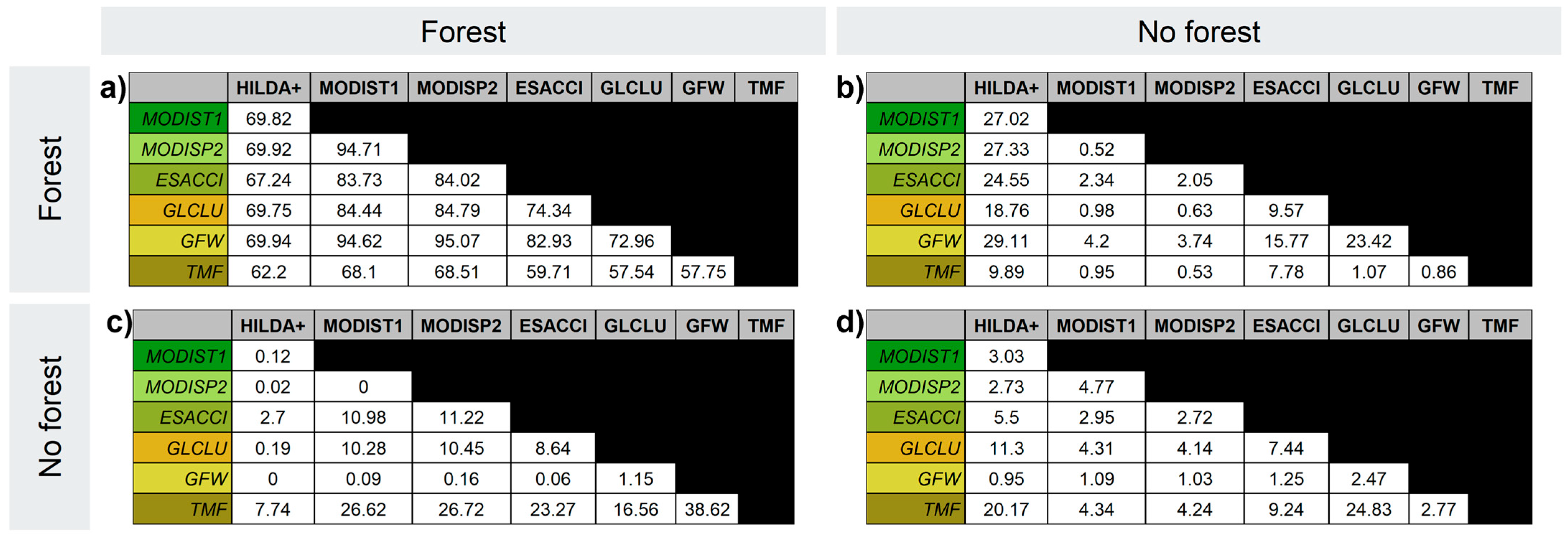
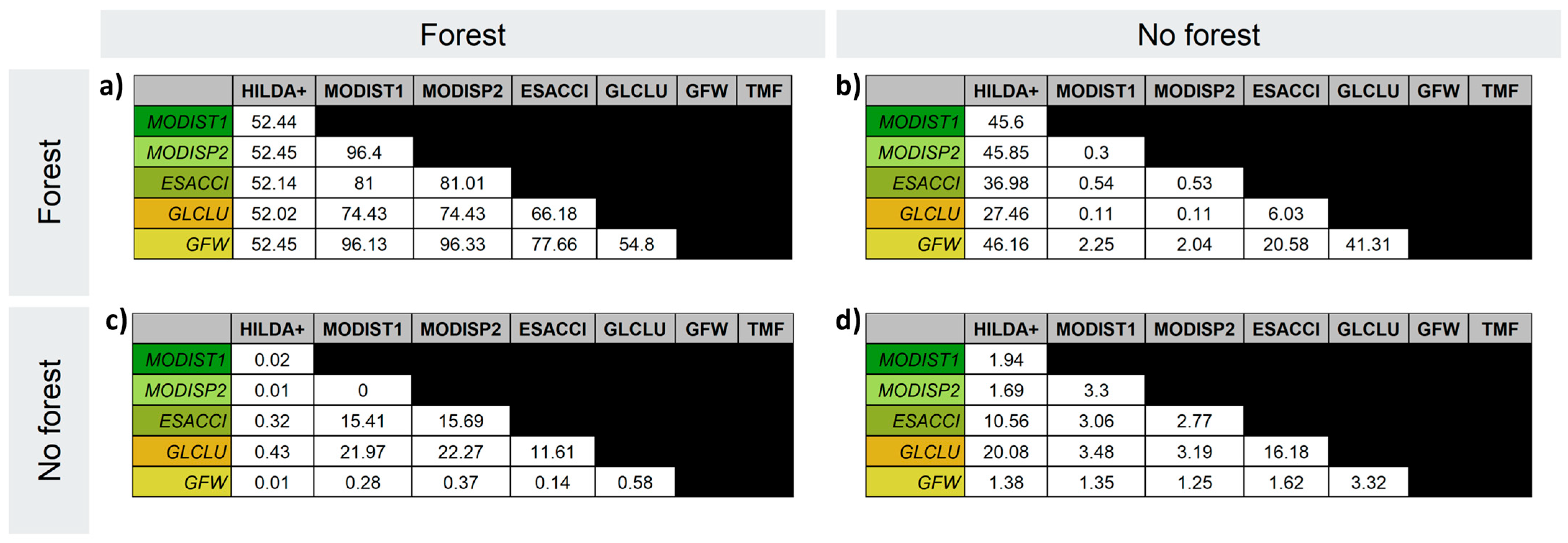
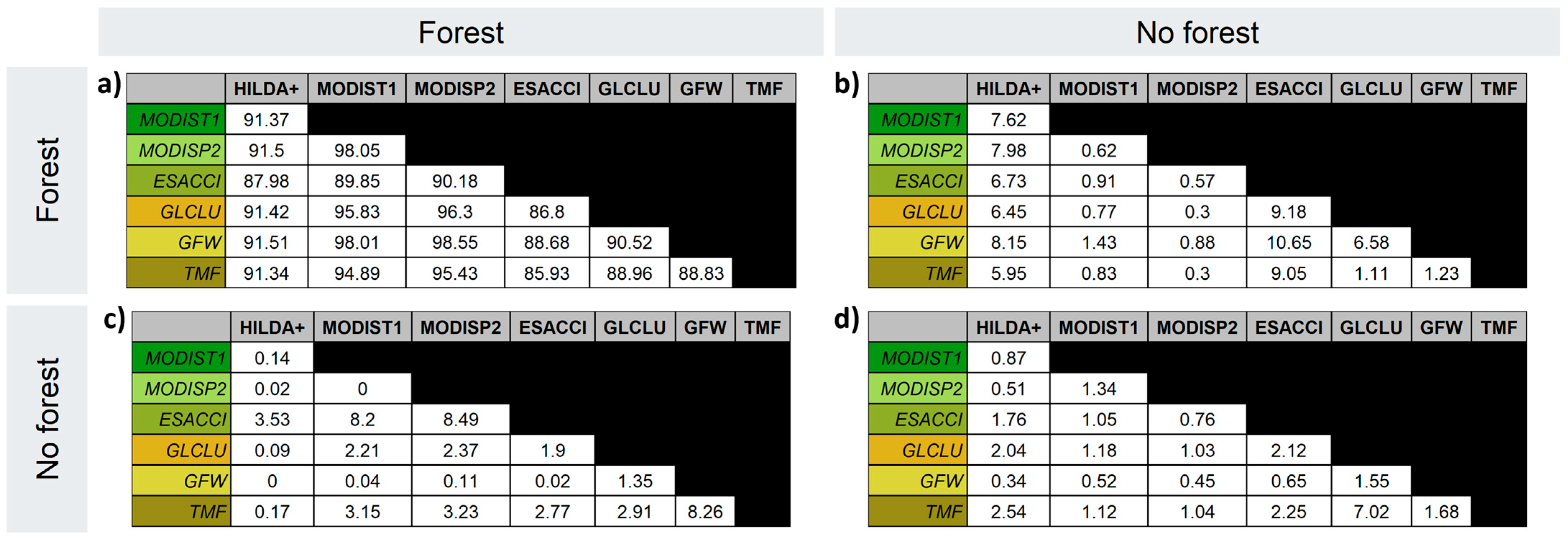
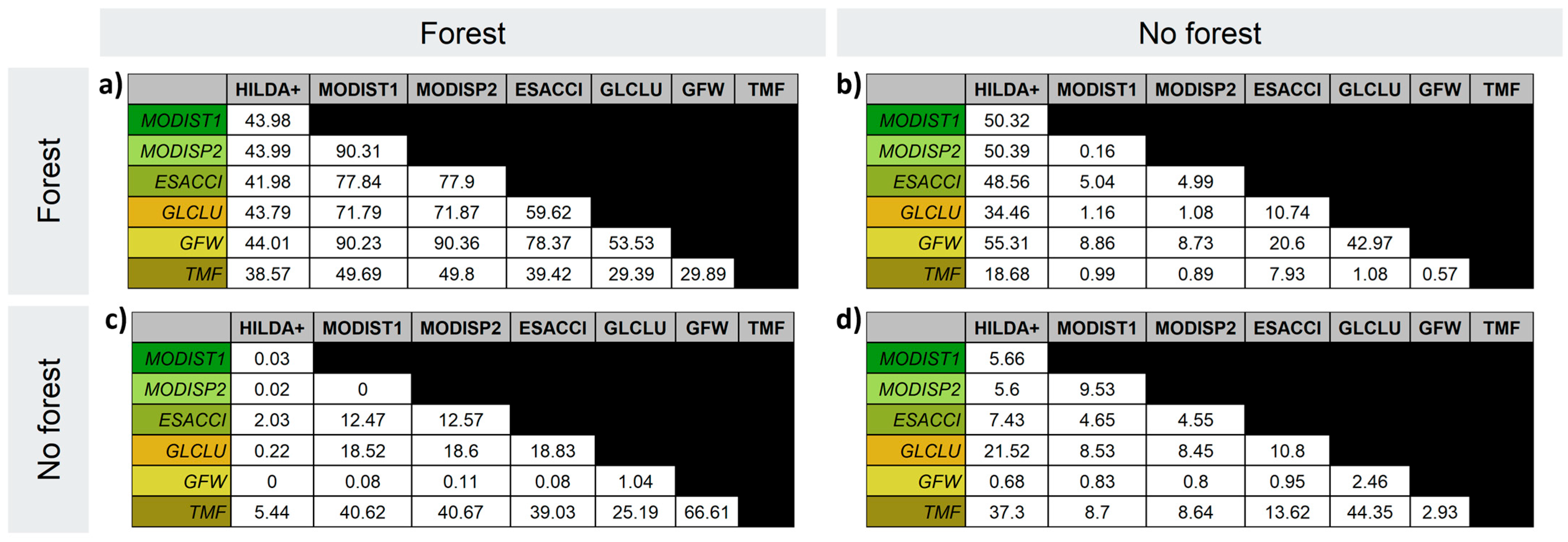
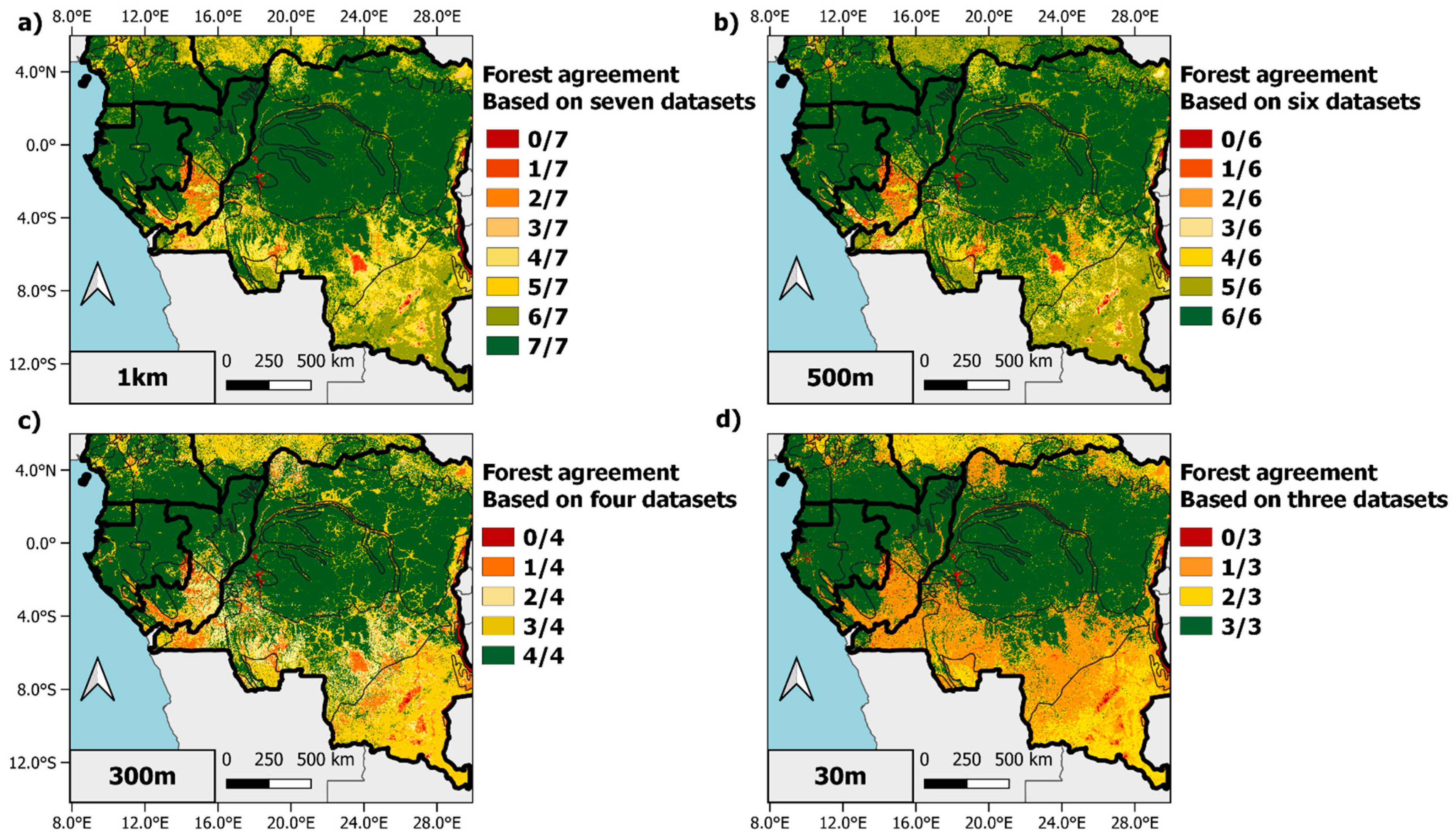
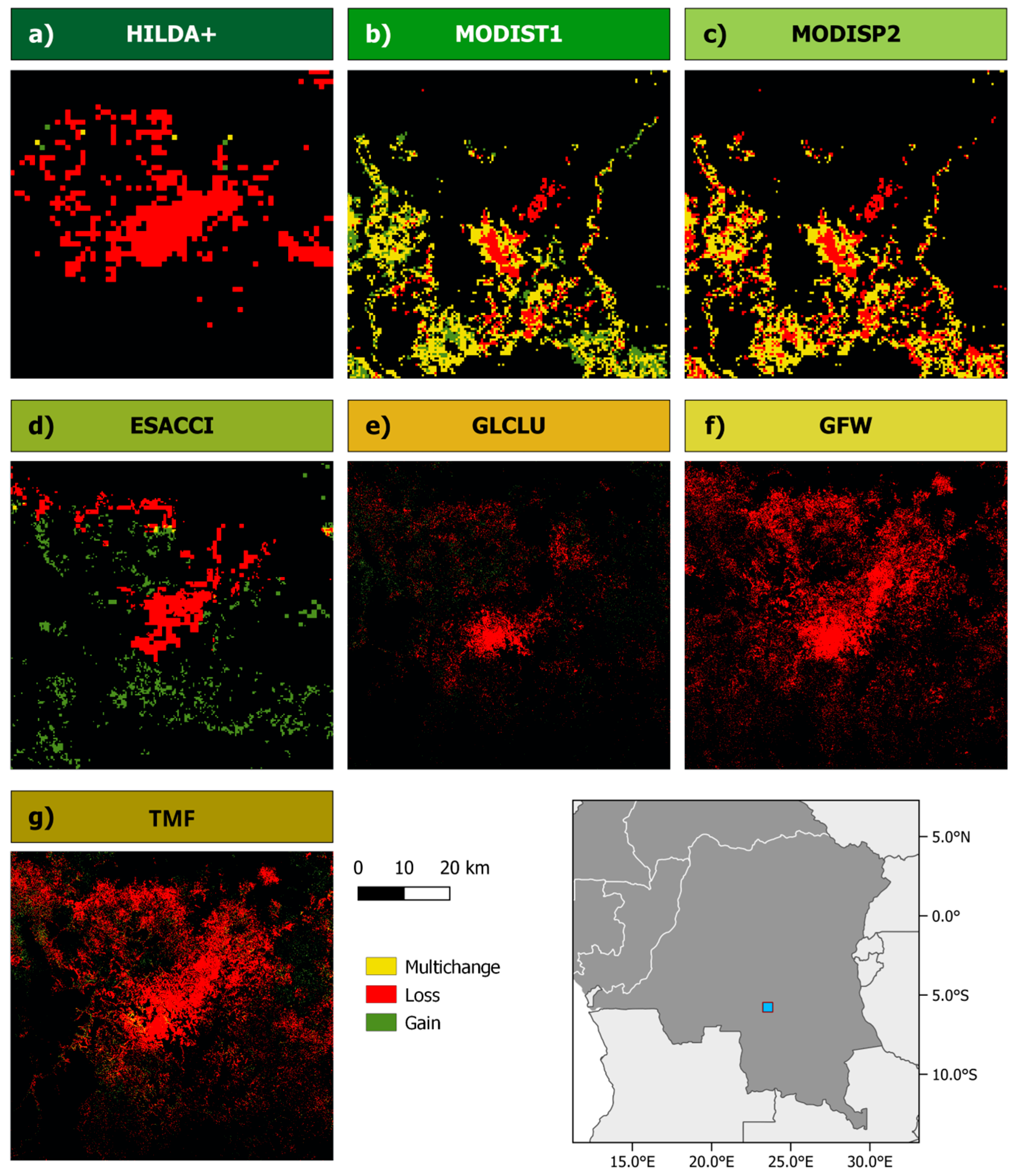
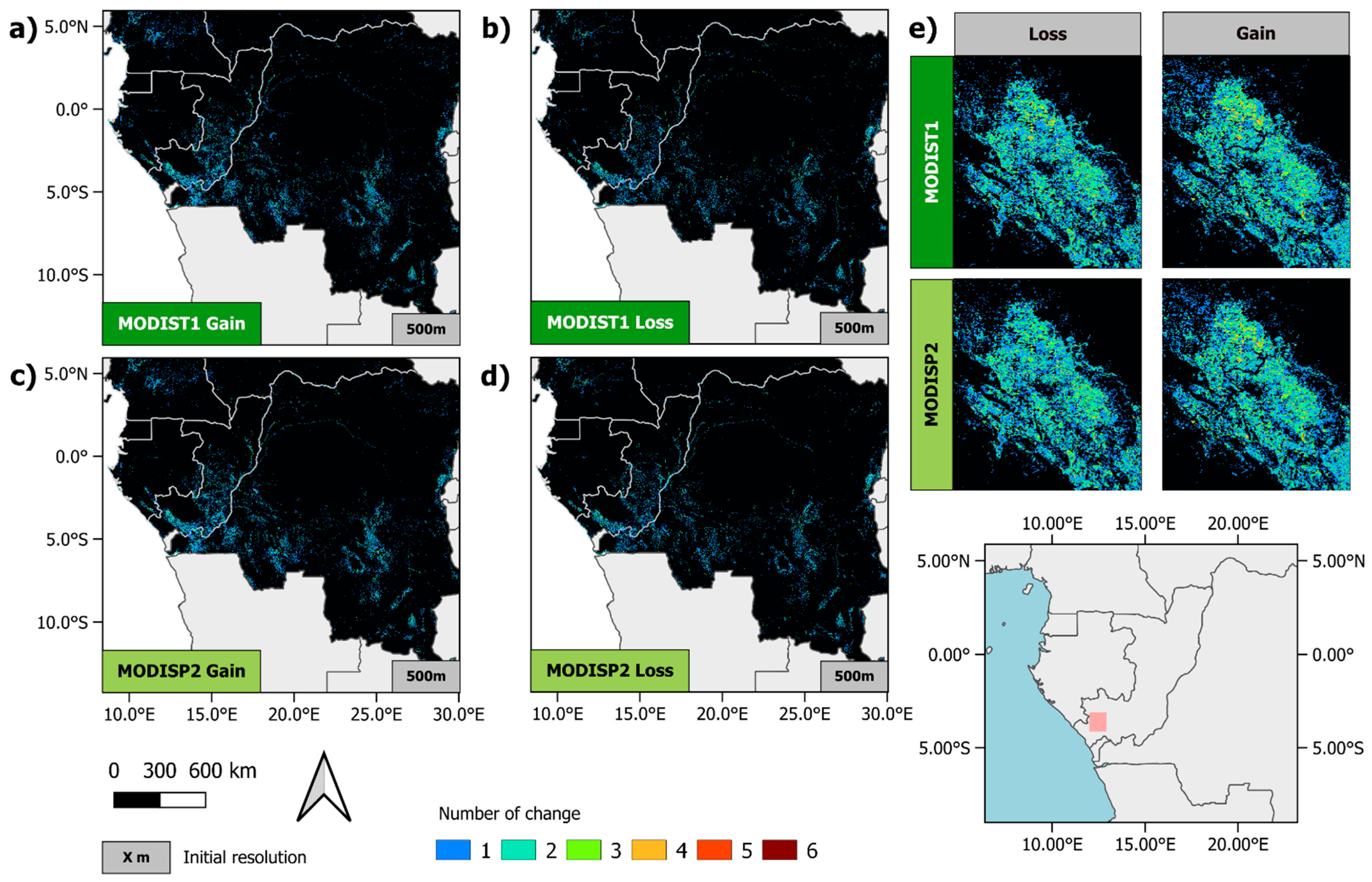
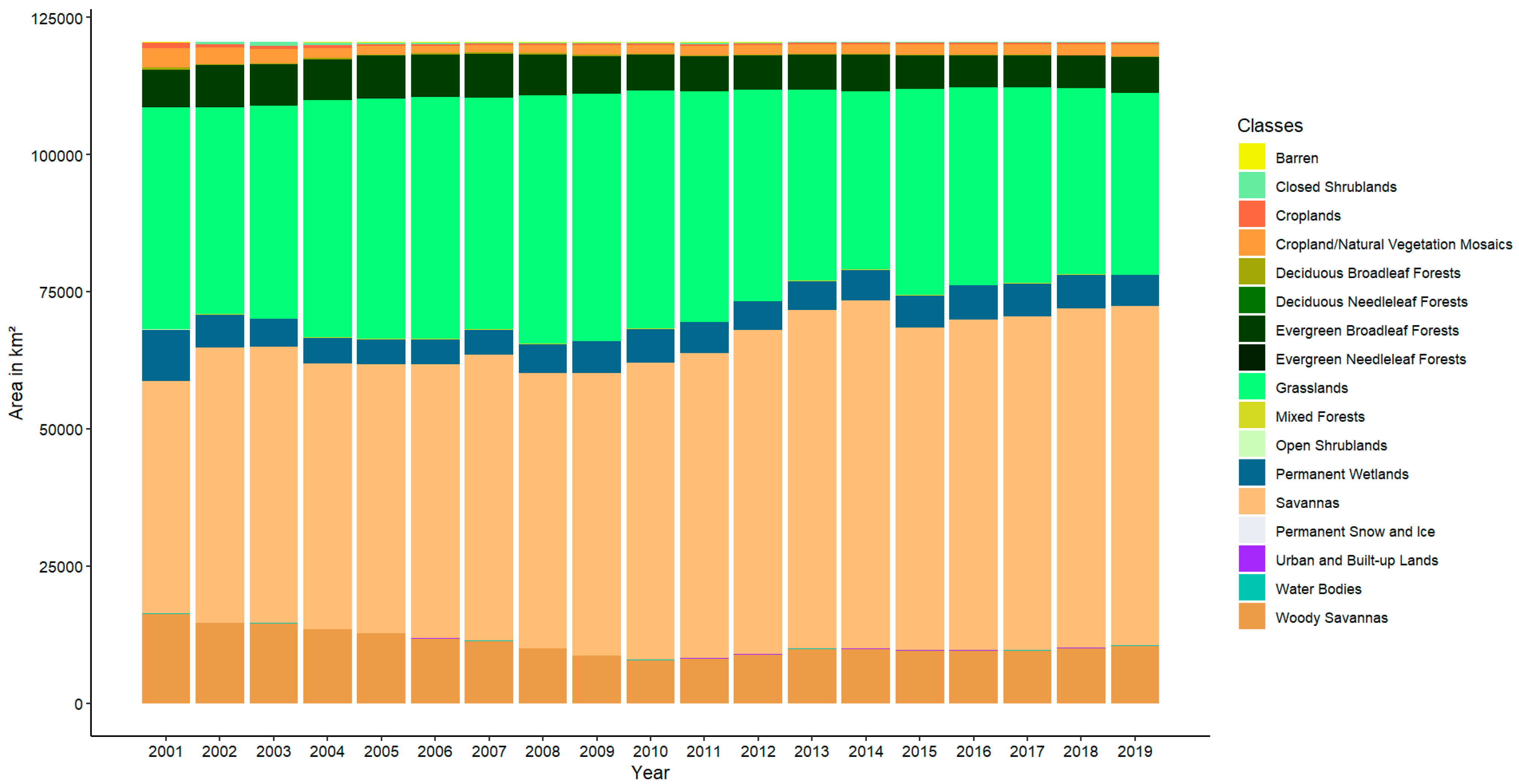
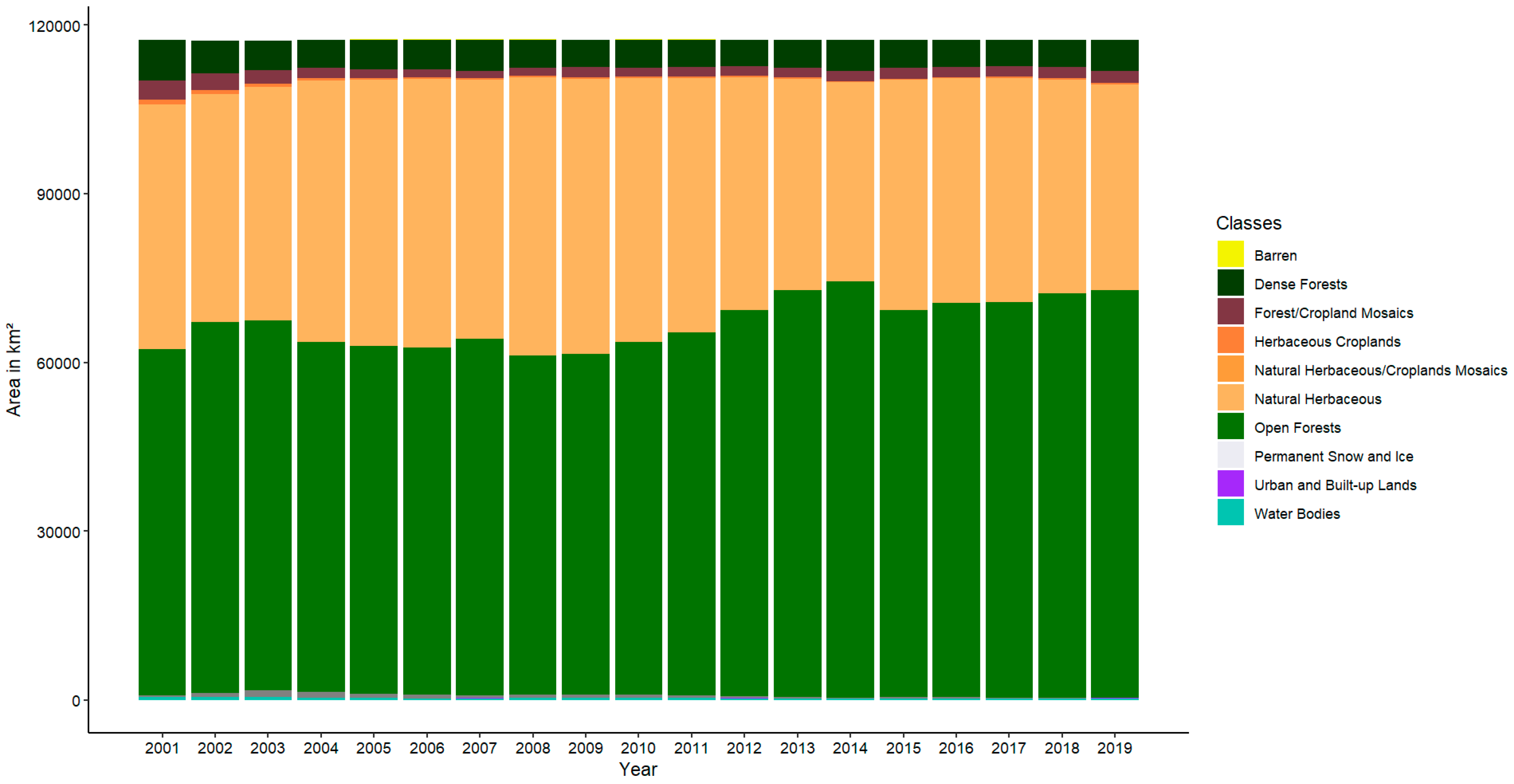
References
- Cuni-Sanchez, A.; Sullivan, M.J.P.; Platts, P.J.; Lewis, S.L.; Marchant, R.; Imani, G.; Hubau, W.; Abiem, I.; Adhikari, H.; Albrecht, T.; et al. High Aboveground Carbon Stock of African Tropical Montane Forests. Nature 2021, 596, 536–542. [Google Scholar] [CrossRef]
- Spracklen, D.V.; Arnold, S.R.; Taylor, C.M. Observations of Increased Tropical Rainfall Preceded by Air Passage over Forests. Nature 2012, 489, 282–285. [Google Scholar] [CrossRef]
- Réjou-Méchain, M.; Mortier, F.; Bastin, J.-F.; Cornu, G.; Barbier, N.; Bayol, N.; Bénédet, F.; Bry, X.; Dauby, G.; Deblauwe, V.; et al. Unveiling African Rainforest Composition and Vulnerability to Global Change. Nature 2021, 593, 90–94. [Google Scholar] [CrossRef]
- Hubau, W.; Lewis, S.L.; Phillips, O.L.; Affum-Baffoe, K.; Beeckman, H.; Cuní-Sanchez, A.; Daniels, A.K.; Ewango, C.E.N.; Fauset, S.; Mukinzi, J.M.; et al. Asynchronous Carbon Sink Saturation in African and Amazonian Tropical Forests. Nature 2020, 579, 80–87. [Google Scholar] [CrossRef]
- Foley, J.A.; DeFries, R.; Asner, G.P.; Barford, C.; Bonan, G.; Carpenter, S.R.; Chapin, F.S.; Coe, M.T.; Daily, G.C.; Gibbs, H.K.; et al. Global Consequences of Land Use. Science 2005, 309, 570–574. [Google Scholar] [CrossRef] [PubMed]
- Curtis, P.G.; Slay, C.M.; Harris, N.L.; Tyukavina, A.; Hansen, M.C. Classifying Drivers of Global Forest Loss. Science 2018, 361, 1108–1111. [Google Scholar] [CrossRef] [PubMed]
- Global Forest Resources Assessment 2020; FAO: Rome, Italy, 2020; ISBN 978-92-5-132581-0.
- Kissinger, G.; Herold, M.; De sy, V. Drivers of Deforestation and Forest Degradation: A Synthesis Report for REDD+ Policymakers; Lexeme Consulting: Vancouver, BC, Canada, 2012. [Google Scholar]
- de Wasseige, C.; Tadoum, M.; Eba’a Atyi, R.; Doumenge, C. (Eds.) Les Forêts du Bassin du Congo: Forêts et Changements Climatiques; Weyrich Édition: Neufchâteau, Belgium, 2015; ISBN 978-2-87489-356-8. [Google Scholar]
- Jiang, N.; Li, P.; Feng, Z. Remote Sensing of Swidden Agriculture in the Tropics: A Review. Int. J. Appl. Earth Obs. Geoinf. 2022, 112, 102876. [Google Scholar] [CrossRef]
- Gibbs, H.K.; Brown, S.; Niles, J.O.; Foley, J.A. Monitoring and Estimating Tropical Forest Carbon Stocks: Making REDD a Reality. Environ. Res. Lett. 2007, 2, 045023. [Google Scholar] [CrossRef]
- Bossy, T.; Ciais, P.; Renaudineau, S.; Wan, L.; Ygorra, B.; Adam, E.; Barbier, N.; Bauters, M.; Delbart, N.; Frappart, F.; et al. State of the Art and for Remote Sensing Monitoring of Carbon Dynamics in African Tropical Forests. Front. Remote Sens. 2025, 6, 1532280. [Google Scholar] [CrossRef]
- Chave, J.; Davies, S.J.; Phillips, O.L.; Lewis, S.L.; Sist, P.; Schepaschenko, D.; Armston, J.; Baker, T.R.; Coomes, D.; Disney, M.; et al. Ground Data Are Essential for Biomass Remote Sensing Missions. Surv. Geophys. 2019, 40, 863–880. [Google Scholar] [CrossRef]
- Potapov, P.; Hansen, M.C.; Pickens, A.; Hernandez-Serna, A.; Tyukavina, A.; Turubanova, S.; Zalles, V.; Li, X.; Khan, A.; Stolle, F.; et al. The Global 2000-2020 Land Cover and Land Use Change Dataset Derived From the Landsat Archive: First Results. Front. Remote Sens. 2022, 3, 856903. [Google Scholar] [CrossRef]
- ESA Land Cover CCI Product User Guide Version 2. Tech. Rep. 2017. Available online: http://maps.elie.ucl.ac.be/CCI/viewer/download/ESACCI-LC-Ph2-PUGv2_2.0.pdf (accessed on 19 February 2025).
- Sulla-Menashe, D.; Gray, J.M.; Abercrombie, S.P.; Friedl, M.A. Hierarchical Mapping of Annual Global Land Cover 2001 to Present: The MODIS Collection 6 Land Cover Product. Remote Sens. Environ. 2019, 222, 183–194. [Google Scholar] [CrossRef]
- Winkler, K.; Fuchs, R.; Rounsevell, M.; Herold, M. Global Land Use Changes Are Four Times Greater than Previously Estimated. Nat. Commun. 2021, 12, 2501. [Google Scholar] [CrossRef] [PubMed]
- Hansen, M.C.; Potapov, P.V.; Moore, R.; Hancher, M.; Turubanova, S.A.; Tyukavina, A.; Thau, D.; Stehman, S.V.; Goetz, S.J.; Loveland, T.R.; et al. High-Resolution Global Maps of 21st-Century Forest Cover Change. Science 2013, 342, 850–853. [Google Scholar] [CrossRef]
- Vancutsem, C.; Achard, F.; Pekel, J.-F.; Vieilledent, G.; Carboni, S.; Simonetti, D.; Gallego, J.; Aragão, L.E.O.C.; Nasi, R. Long-Term (1990–2019) Monitoring of Forest Cover Changes in the Humid Tropics. Sci. Adv. 2021, 7, eabe1603. [Google Scholar] [CrossRef]
- Ryan, C.M.; Hill, T.; Woollen, E.; Ghee, C.; Mitchard, E.; Cassells, G.; Grace, J.; Woodhouse, I.H.; Williams, M. Quantifying Small-scale Deforestation and Forest Degradation in African Woodlands Using Radar Imagery. Glob. Change Biol. 2012, 18, 243–257. [Google Scholar] [CrossRef]
- Mitchard, E.T.A.; Saatchi, S.S.; White, L.J.T.; Abernethy, K.A.; Jeffery, K.J.; Lewis, S.L.; Collins, M.; Lefsky, M.A.; Leal, M.E.; Woodhouse, I.H.; et al. Mapping Tropical Forest Biomass with Radar and Spaceborne LiDAR in Lopé National Park, Gabon: Overcoming Problems of High Biomass and Persistent Cloud. Biogeosciences 2012, 9, 179–191. [Google Scholar] [CrossRef]
- Beck, H.E.; Zimmermann, N.E.; McVicar, T.R.; Vergopolan, N.; Berg, A.; Wood, E.F. Present and Future Köppen-Geiger Climate Classification Maps at 1-Km Resolution. Sci. Data 2018, 5, 180214. [Google Scholar] [CrossRef]
- Olson, D.M.; Dinerstein, E.; Wikramanayake, E.D.; Burgess, N.D.; Powell, G.V.N.; Underwood, E.C.; D’amico, J.A.; Itoua, I.; Strand, H.E.; Morrison, J.C.; et al. Terrestrial Ecoregions of the World: A New Map of Life on Earth. BioScience 2001, 51, 933. [Google Scholar] [CrossRef]
- Martin, E.; Burgess, N. Central Zambezian Wet Miombo Woodlands (AT11) 2020. Available online: https://www.oneearth.org/ecoregions/central-zambezian-wet-miombo-woodlands/ (accessed on 19 February 2025).
- Kanschik, W.; Becker, B. Dry Miombo – Ecology of Its Major Plant Species and Their Potential Use as Bio-Indicators. Plant Ecology 2001, 155, 139–146. [Google Scholar] [CrossRef]
- Martin, E.; Burgess, N. Central Congolian Lowland Forest (AT14) 2020. Available online: https://www.oneearth.org/ecoregions/central-congolian-lowland-forests/ (accessed on 19 February 2025).
- Martin, E.; Burgess, N. Southern Congolian Forest-Savanna (AT13) 2020. Available online: https://www.oneearth.org/ecoregions/southern-congolian-forest-savanna/ (accessed on 19 February 2025).
- Burgess, N.D.; D’Amico Hales, J.; Dinerstein, E.; Itoua, I.; Newman, K.; Olson, D.; Ricketts, T.; Schipper, J.; Underwood, E. Terrestrial Ecoregions of Africa and Madagascar: A Conservation Assessment; Island Press: Washington, DC, USA, 2004; ISBN 978-1-55963-364-2. [Google Scholar]
- Ogle, S.M.; Sanchez, M.J.S.; Rocha, M.T.; MacDonald, J.D.; Dong, H. IPCC Guidelines for National Greenhouse Gas Inventories, Volume 4 (Agriculture, Forestry and Other Land Use); National Greenhouse Gas Inventories Program; IPCC: Geneva, Switzerland, 2019.
- Chazdon, R.L.; Brancalion, P.H.S.; Laestadius, L.; Bennett-Curry, A.; Buckingham, K.; Kumar, C.; Moll-Rocek, J.; Vieira, I.C.G.; Wilson, S.J. When Is a Forest a Forest? Forest Concepts and Definitions in the Era of Forest and Landscape Restoration. Ambio 2016, 45, 538–550. [Google Scholar] [CrossRef]
- Tropek, R.; Sedláček, O.; Beck, J.; Keil, P.; Musilová, Z.; Šímová, I.; Storch, D. Comment on “High-Resolution Global Maps of 21st-Century Forest Cover Change”. Science 2014, 344, 981. [Google Scholar] [CrossRef]
- Sannier, C.; McRoberts, R.E.; Fichet, L.-V. Suitability of Global Forest Change Data to Report Forest Cover Estimates at National Level in Gabon. Remote Sens. Environ. 2016, 173, 326–338. [Google Scholar] [CrossRef]
- Dong, J.; Xiao, X.; Sheldon, S.; Biradar, C.; Zhang, G.; Dinh Duong, N.; Hazarika, M.; Wikantika, K.; Takeuhci, W.; Moore, B. A 50-m Forest Cover Map in Southeast Asia from ALOS/PALSAR and Its Application on Forest Fragmentation Assessment. PLoS ONE 2014, 9, e85801. [Google Scholar] [CrossRef] [PubMed]
- Li, W.; Ciais, P.; MacBean, N.; Peng, S.; Defourny, P.; Bontemps, S. Major Forest Changes and Land Cover Transitions Based on Plant Functional Types Derived from the ESA CCI Land Cover Product. Int. J. Appl. Earth Obs. Geoinf. 2016, 47, 30–39. [Google Scholar] [CrossRef]
- Liu, A.; Cheng, X.; Chen, Z. Performance Evaluation of GEDI and ICESat-2 Laser Altimeter Data for Terrain and Canopy Height Retrievals. Remote Sens. Environ. 2021, 264, 112571. [Google Scholar] [CrossRef]
- Fayad, I.; Baghdadi, N.; Alcarde Alvares, C.; Stape, J.L.; Bailly, J.S.; Scolforo, H.F.; Cegatta, I.R.; Zribi, M.; Le Maire, G. Terrain Slope Effect on Forest Height and Wood Volume Estimation from GEDI Data. Remote Sens. 2021, 13, 2136. [Google Scholar] [CrossRef]
- Hamunyela, E.; Brandt, P.; Shirima, D.; Do, H.T.T.; Herold, M.; Roman-Cuesta, R.M. Space-Time Detection of Deforestation, Forest Degradation and Regeneration in Montane Forests of Eastern Tanzania. Int. J. Appl. Earth Obs. Geoinf. 2020, 88, 102063. [Google Scholar] [CrossRef]
- Mutanga, O.; Masenyama, A.; Sibanda, M. Spectral Saturation in the Remote Sensing of High-Density Vegetation Traits: A Systematic Review of Progress, Challenges, and Prospects. ISPRS J. Photogramm. Remote Sens. 2023, 198, 297–309. [Google Scholar] [CrossRef]
- Joshi, N.; Mitchard, E.T.A.; Brolly, M.; Schumacher, J.; Fernández-Landa, A.; Johannsen, V.K.; Marchamalo, M.; Fensholt, R. Understanding ‘Saturation’ of Radar Signals over Forests. Sci. Rep. 2017, 7, 3505. [Google Scholar] [CrossRef]
- Melo, J.B.; Ziv, G.; Baker, T.R.; Carreiras, J.M.B.; Pearson, T.R.H.; Vasconcelos, M.J. Striking Divergences in Earth Observation Products May Limit Their Use for REDD+. Environ. Res. Lett. 2018, 13, 104020. [Google Scholar] [CrossRef]
- Hakkenberg, C.R.; Atkins, J.W.; Brodie, J.F.; Burns, P.; Cushman, S.; Jantz, P.; Kaszta, Z.; Quinn, C.A.; Rose, M.D.; Goetz, S.J. Inferring Alpha, Beta, and Gamma Plant Diversity across Biomes with GEDI Spaceborne Lidar. Environ. Res. Ecol. 2023, 2, 035005. [Google Scholar] [CrossRef]
- Reiche, J.; Mullissa, A.; Slagter, B.; Gou, Y.; Tsendbazar, N.-E.; Odongo-Braun, C.; Vollrath, A.; Weisse, M.J.; Stolle, F.; Pickens, A.; et al. Forest Disturbance Alerts for the Congo Basin Using Sentinel-1. Environ. Res. Lett. 2021, 16, 024005. [Google Scholar] [CrossRef]
- Torresani, M.; Rocchini, D.; Alberti, A.; Moudrý, V.; Heym, M.; Thouverai, E.; Kacic, P.; Tomelleri, E. LiDAR GEDI Derived Tree Canopy Height Heterogeneity Reveals Patterns of Biodiversity in Forest Ecosystems. Ecol. Inform. 2023, 76, 102082. [Google Scholar] [CrossRef] [PubMed]
- Ygorra, B.; Frappart, F.; Wigneron, J.P.; Moisy, C.; Catry, T.; Baup, F.; Hamunyela, E.; Riazanoff, S. Monitoring Loss of Tropical Forest Cover from Sentinel-1 Time-Series: A CuSum-Based Approach. Int. J. Appl. Earth Obs. Geoinf. 2021, 103, 102532. [Google Scholar] [CrossRef]
- Ygorra, B.; Frappart, F.; Wigneron, J.-P.; Catry, T.; Pillot, B.; Pfefer, A.; Courtalon, J.; Riazanoff, S. A Near-Real-Time Tropical Deforestation Monitoring Algorithm Based on the CuSum Change Detection Method. Front. Remote Sens. 2024, 5, 1416550. [Google Scholar] [CrossRef]
- Reiche, J.; Hamunyela, E.; Verbesselt, J.; Hoekman, D.; Herold, M. Improving Near-Real Time Deforestation Monitoring in Tropical Dry Forests by Combining Dense Sentinel-1 Time Series with Landsat and ALOS-2 PALSAR-2. Remote Sens. Environ. 2018, 204, 147–161. [Google Scholar] [CrossRef]
- Potapov, P.; Li, X.; Hernandez-Serna, A.; Tyukavina, A.; Hansen, M.C.; Kommareddy, A.; Pickens, A.; Turubanova, S.; Tang, H.; Silva, C.E.; et al. Mapping Global Forest Canopy Height through Integration of GEDI and Landsat Data. Remote Sens. Environ. 2021, 253, 112165. [Google Scholar] [CrossRef]
- Lang, N.; Jetz, W.; Schindler, K.; Wegner, J.D. A High-Resolution Canopy Height Model of the Earth. Nat. Ecol. Evol. 2023, 7, 1778–1789. [Google Scholar] [CrossRef]
- Fayad, I.; Ciais, P.; Schwartz, M.; Wigneron, J.-P.; Baghdadi, N.; De Truchis, A.; d’Aspremont, A.; Frappart, F.; Saatchi, S.; Sean, E.; et al. Hy-TeC: A Hybrid Vision Transformer Model for High-Resolution and Large-Scale Mapping of Canopy Height. Remote Sens. Environ. 2024, 302, 113945. [Google Scholar] [CrossRef]
- Sollier, V.; Frappart, F.; Bourrel, L.; Couvreur, T.L.P.; Peaucelle, M.; Renaudineau, S.; Huaraca, L.; Wigneron, J.-P. Long-Term Evolution of Forest Cover in the Pacific Coast of Ecuador (1960–2019): A Comparison of Land Use/Land Cover (LULC) Remote Sensing Products. Front. Remote Sens. 2025, 6, 1536105. [Google Scholar] [CrossRef]
- Sankaran, M.; Hanan, N.P.; Scholes, R.J.; Ratnam, J.; Augustine, D.J.; Cade, B.S.; Gignoux, J.; Higgins, S.I.; Le Roux, X.; Ludwig, F.; et al. Determinants of Woody Cover in African Savannas. Nature 2005, 438, 846–849. [Google Scholar] [CrossRef] [PubMed]
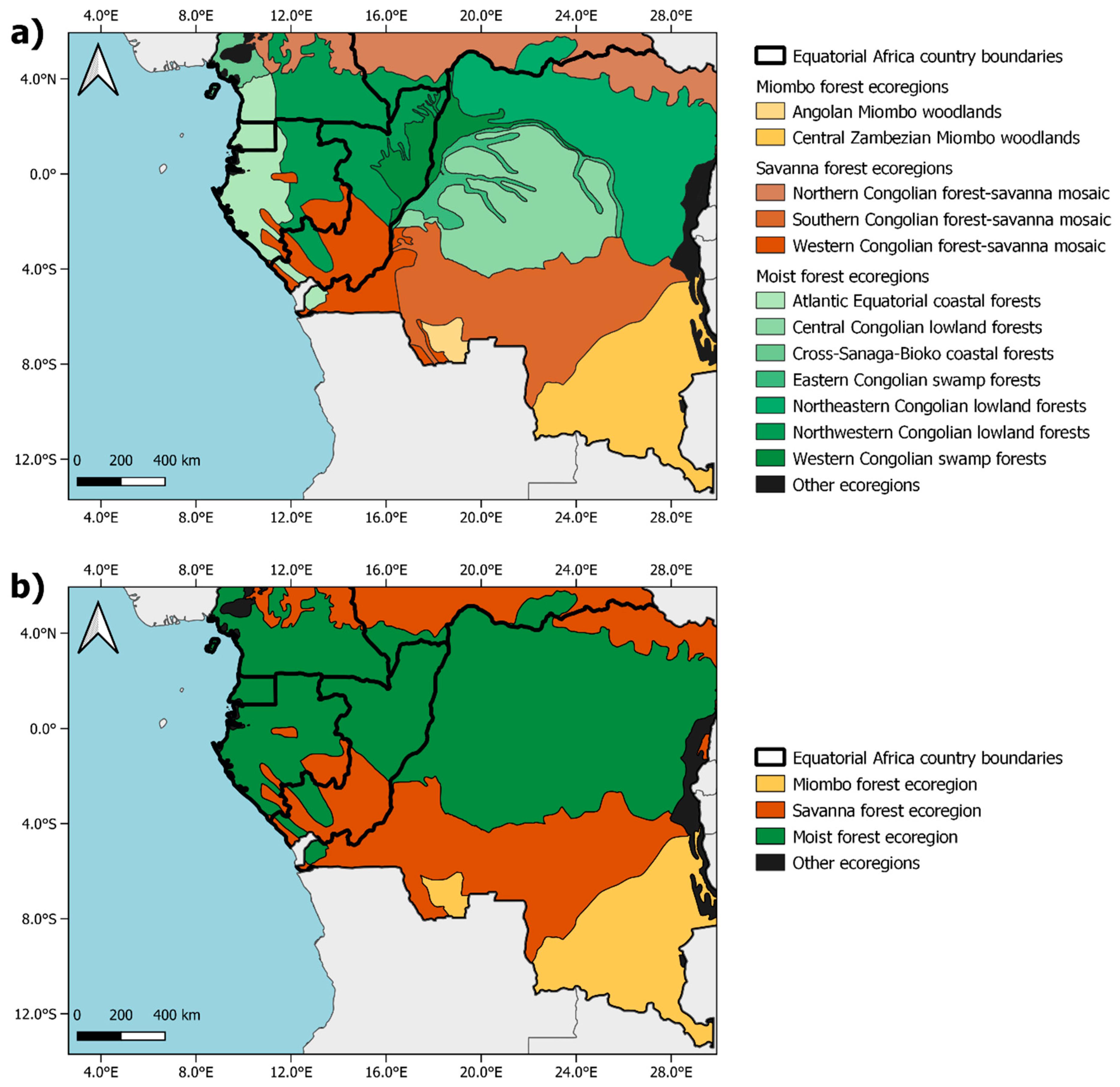
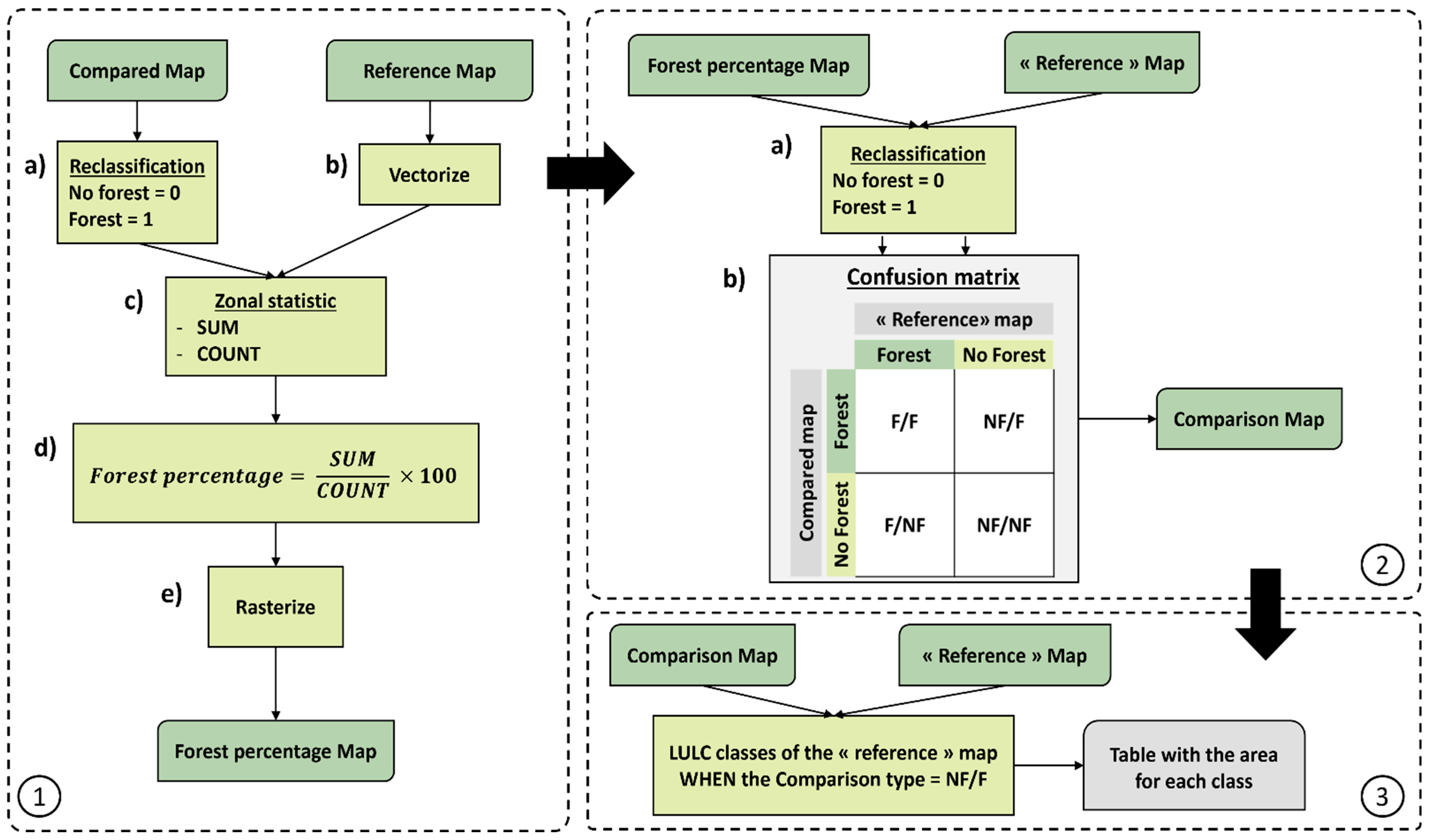
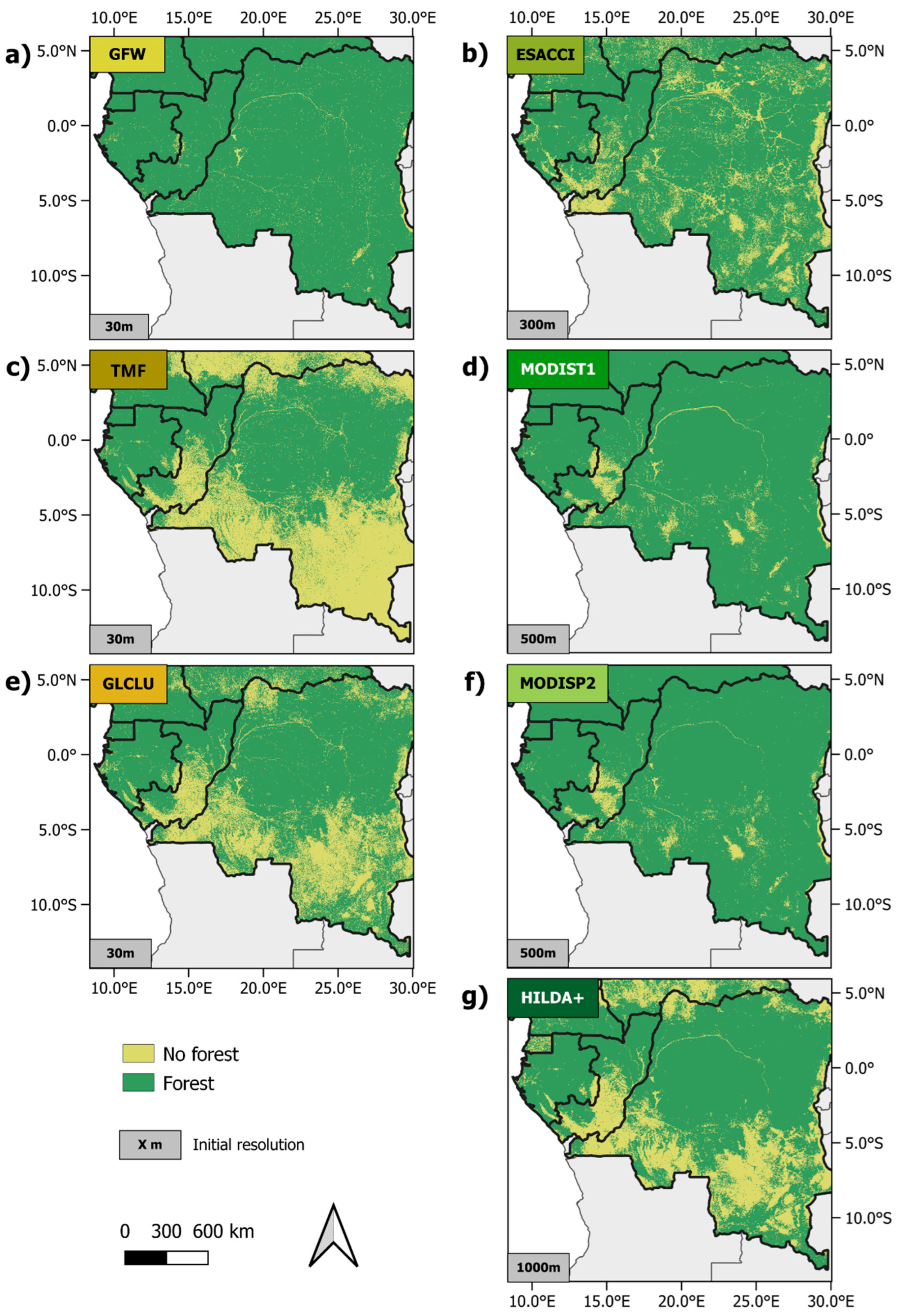
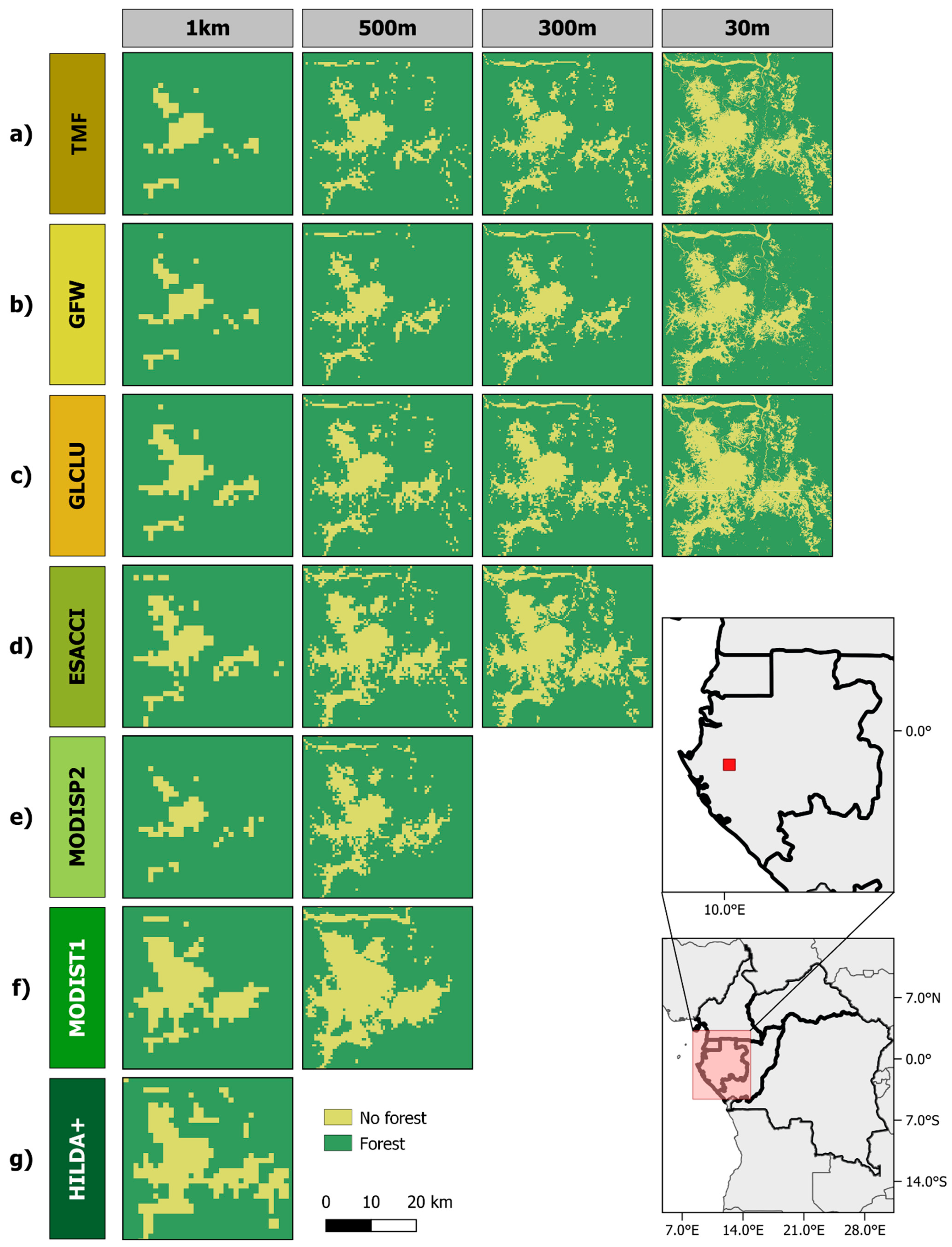
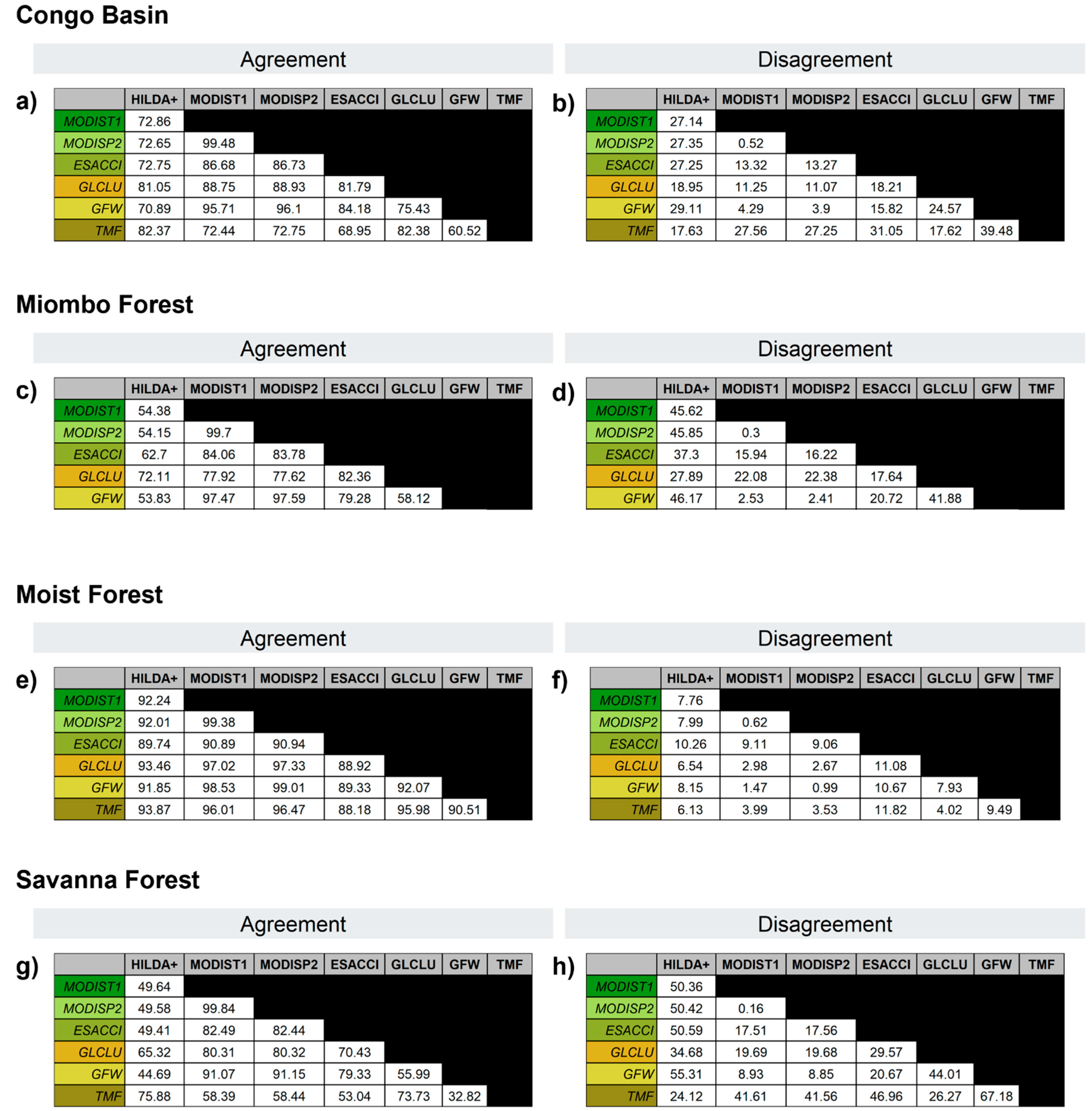
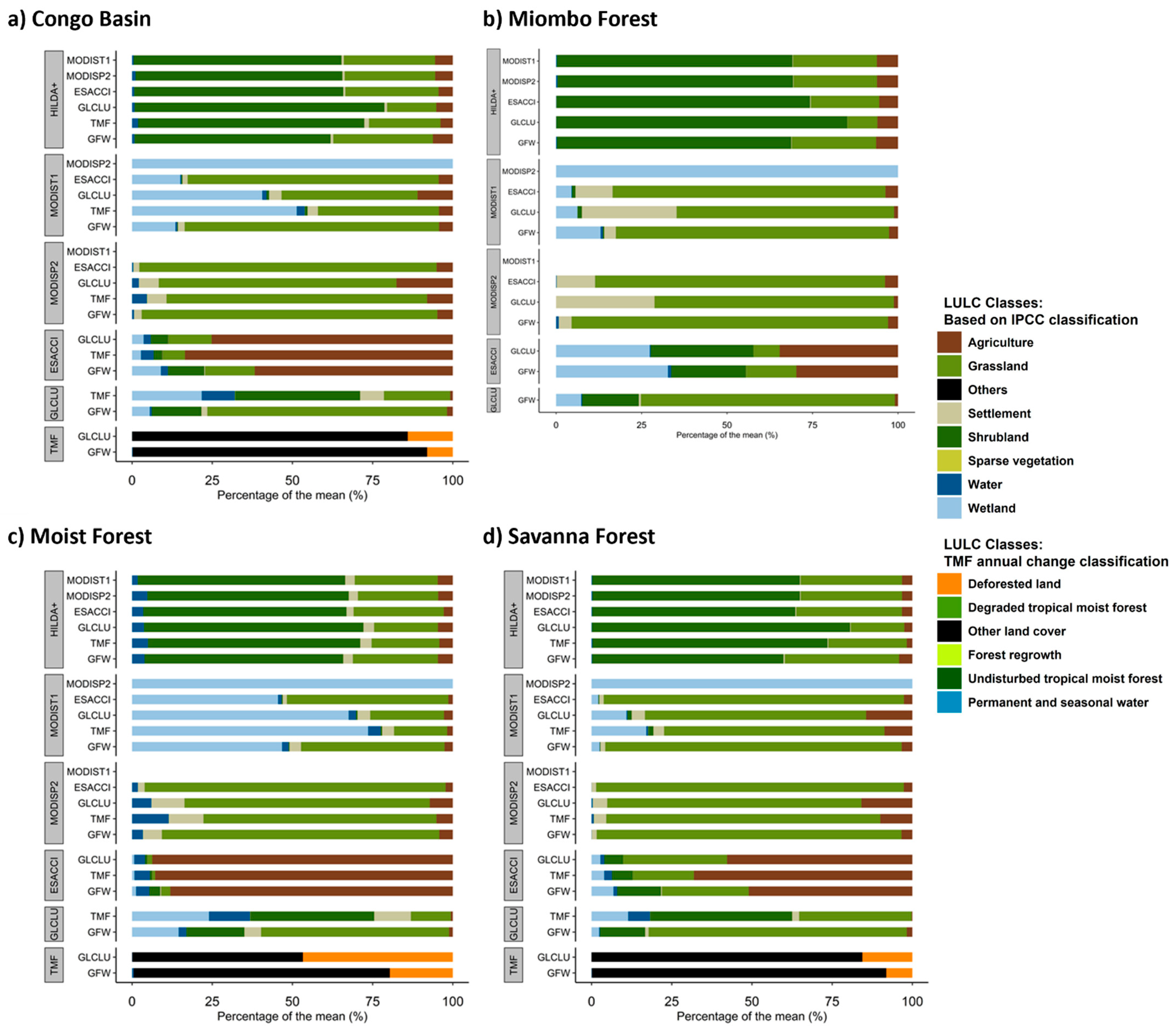
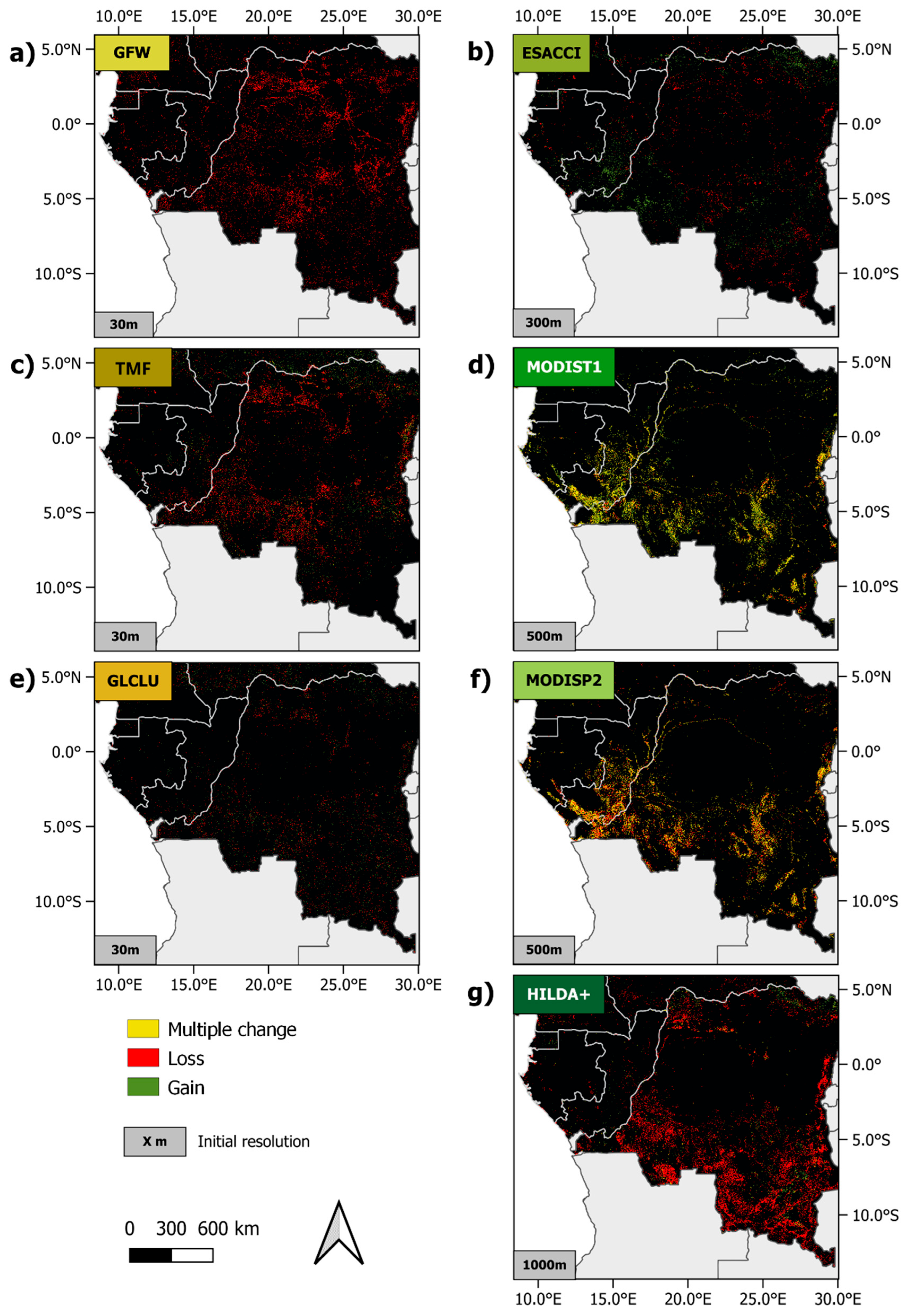
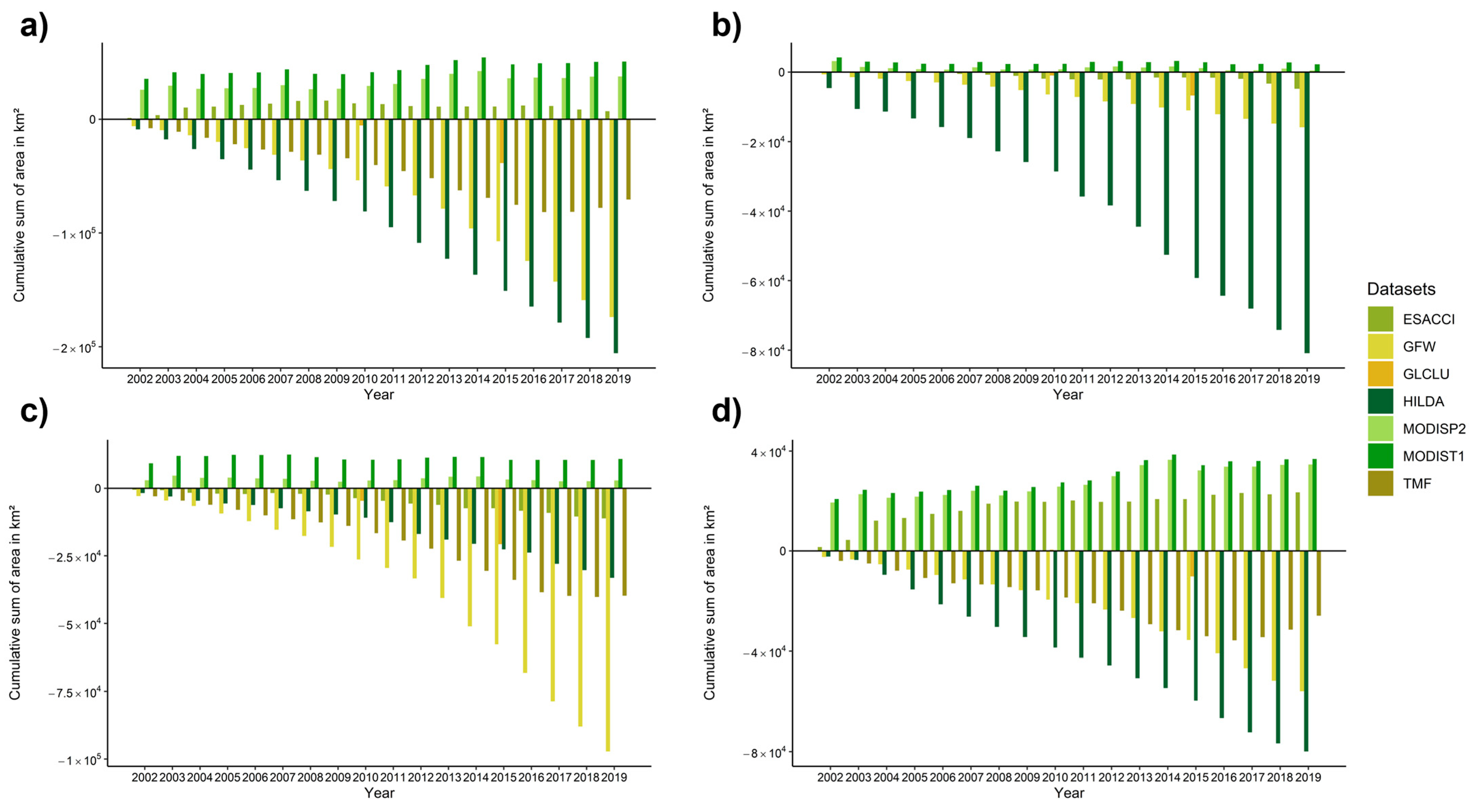
| HILDA+ | MODIST1 | MODISP2 | ESACCI | GLCLU | GFW | TMF | |
|---|---|---|---|---|---|---|---|
| Spatial resolution | 1000 m | 500 m | 500 m | 300 m | 30 m | 30 m | 30 m |
| Temporal resolution | Annual | Annual | Annual | Annual | Every 5 years | Annual | Annual |
| Temporal coverage | 1960–2019 | 2001–2022 | 2001–2022 | 1992–2020 | 2000–2020 | 2000–2022 | 1990–2022 |
| Sensors | Multi-source | MODIS | MODIS | AVHRR, MERIS, SPOT-VGT, PROBA-V, S3-OLCI | Landsat GEDI | Landsat | Landsat |
| Classification methodology | Supervised | Supervised | Supervised | Unsupervised | Supervised | Supervised | Supervised |
| Number of classes | 6 | 18 | 12 | 36 | 110 | Continuous tree cover between 0 and 100% Year of forest loss | 6 |
| Congo Basin | Miombo | Moist forest | Savanna | ||||||
|---|---|---|---|---|---|---|---|---|---|
| Dataset | Non-Forest Percentage | Forest Percentage | Non-Forest Percentage | Forest Percentage | Non-Forest Percentage | Forest Percentage | Non-Forest Percentage | Forest Percentage | Resolution |
| HILDA+ | 30.16 | 69.84 | 47.89 | 52.11 | 8.54 | 91.46 | 56.04 | 43.96 | 1 km |
| MODIST1 | 3.16 | 96.84 | 1.96 | 98.04 | 1.01 | 98.99 | 5.70 | 94.30 | 1 km |
| MODISP2 | 2.75 | 97.25 | 1.70 | 98.30 | 0.53 | 99.47 | 5.62 | 94.38 | 1 km |
| ESACCI | 8.20 | 91.80 | 10.88 | 89.12 | 5.29 | 94.71 | 9.46 | 90.54 | 1 km |
| GLCLU | 11.49 | 88.51 | 20.51 | 79.49 | 2.13 | 97.87 | 21.75 | 78.25 | 1 km |
| GFW | 0.95 | 99.05 | 1.39 | 98.61 | 0.35 | 99.65 | 0.68 | 99.32 | 1 km |
| TMF | 27.91 | 72.09 | 2.71 | 97.29 | 42.74 | 57.26 | 1 km | ||
| MODIST1 | 5.29 | 94.71 | 3.60 | 96.40 | 1.95 | 98.05 | 9.69 | 90.31 | 500 m |
| MODISP2 | 4.77 | 95.23 | 3.30 | 96.70 | 1.34 | 98.66 | 9.53 | 90.47 | 500 m |
| ESACCI | 13.93 | 86.07 | 18.46 | 81.54 | 9.25 | 90.75 | 17.12 | 82.88 | 500 m |
| GLCLU | 14.58 | 85.42 | 25.46 | 74.54 | 3.40 | 96.60 | 27.05 | 72.95 | 500 m |
| GFW | 1.18 | 98.82 | 1.63 | 98.37 | 0.56 | 99.44 | 0.91 | 99.09 | 500 m |
| TMF | 30.96 | 69.04 | 4.27 | 95.73 | 49.31 | 50.69 | 500 m | ||
| ESACCI | 17.02 | 82.98 | 22.20 | 77.80 | 11.30 | 88.70 | 21.55 | 78.45 | 300 m |
| GLCLU | 16.09 | 83.91 | 27.79 | 72.21 | 4.02 | 95.98 | 29.63 | 70.37 | 300 m |
| GFW | 1.30 | 98.70 | 1.76 | 98.24 | 0.67 | 99.33 | 1.03 | 98.97 | 300 m |
| TMF | 32.51 | 67.49 | 5.02 | 94.98 | 52.65 | 47.35 | 300 m | ||
| GLCLU | 25.90 | 74.10 | 44.63 | 55.37 | 8.13 | 91.87 | 45.42 | 54.58 | 30 m |
| GFW | 3.63 | 96.37 | 3.90 | 96.10 | 2.90 | 97.10 | 3.50 | 96.50 | 30 m |
| TMF | 41.40 | 58.60 | 9.94 | 90.06 | 69.54 | 30.46 | 30 m | ||
Disclaimer/Publisher’s Note: The statements, opinions and data contained in all publications are solely those of the individual author(s) and contributor(s) and not of MDPI and/or the editor(s). MDPI and/or the editor(s) disclaim responsibility for any injury to people or property resulting from any ideas, methods, instructions or products referred to in the content. |
© 2025 by the authors. Licensee MDPI, Basel, Switzerland. This article is an open access article distributed under the terms and conditions of the Creative Commons Attribution (CC BY) license (https://creativecommons.org/licenses/by/4.0/).
Share and Cite
Renaudineau, S.; Frappart, F.; Peaucelle, M.; Sollier, V.; Wigneron, J.-P.; Ciais, P.; Ygorra, B. Forest Cover in the Congo Basin: Consistency Evaluation of Seven Datasets. Forests 2025, 16, 1609. https://doi.org/10.3390/f16101609
Renaudineau S, Frappart F, Peaucelle M, Sollier V, Wigneron J-P, Ciais P, Ygorra B. Forest Cover in the Congo Basin: Consistency Evaluation of Seven Datasets. Forests. 2025; 16(10):1609. https://doi.org/10.3390/f16101609
Chicago/Turabian StyleRenaudineau, Solène, Frédéric Frappart, Marc Peaucelle, Valentine Sollier, Jean-Pierre Wigneron, Philippe Ciais, and Bertrand Ygorra. 2025. "Forest Cover in the Congo Basin: Consistency Evaluation of Seven Datasets" Forests 16, no. 10: 1609. https://doi.org/10.3390/f16101609
APA StyleRenaudineau, S., Frappart, F., Peaucelle, M., Sollier, V., Wigneron, J.-P., Ciais, P., & Ygorra, B. (2025). Forest Cover in the Congo Basin: Consistency Evaluation of Seven Datasets. Forests, 16(10), 1609. https://doi.org/10.3390/f16101609







